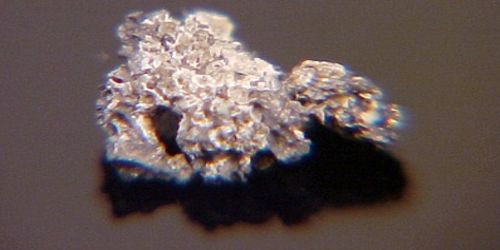Lansfordite is a hydrated magnesium carbonate mineral with composition: MgCO3·5H2O. It is a soft monoclinic hydrated magnesium carbonate mineral. It is a mineral composed of a hydrous basic carbonate of magnesium like paraffin when first taken out of the ground but altering to nesquehonite on exposure.
Landsfordite was discovered in 1888 in a coal mine in Lansford, Pennsylvania.
General information:
- Formula: MgCO3 5H2O
- Color: Colorless (fresh), white (exposed); colorless in transmitted light.
- Hardness: 2½
- Specific Gravity: 1.6
- Crystal System: Monoclinic.

Fig: Lansfordite
Physical Properties
It crystallizes in the monoclinic system and typically occurs as colorless to white prismatic crystals and stalactitic masses. It is a soft mineral, Mohs hardness of 2.5, with a low specific gravity of 1.7. It is transparent to translucent with refractive indices of 1.46 to 1.52.
- Cleavage: {001} Perfect, {100} Distinct
- Density: 1.7
- Diaphaneity: Transparent to Opaque
- Hardness: 2.5 – Finger Nail
- Luminescence: Non-fluorescent.
- Luster: Vitreous – Dull
- Magnetism: Nonmagnetic
- Streak: white
Occurrence: Stalactites pendant from the shale roof of an anthracite coal mine (Nesquehoning, Pennsylvania, USA); in a hydromagnesite deposit (Atlin, Canada); a weathering product of an ultramafic body (Sør-Trøndelag, Norway).
Association: Nesquehonite, hydromagnesite, dypingite.
https://en.wikipedia.org/wiki/Lansfordite
















